| Return home | Return to previous page |
|
When
PANDORA’S BOX
Was on PBS
|
|
Sorry, but I have not studied this movie simply because I do not speak German.
As far as I know, Pandora’s Box was severely censored and altered from its very first public performance,
and had never been seen in anything even remotely resembling its original intentions until 44 years later.
I could be wrong about that.
As far as I know, it was in the early 1970’s that Jim Card found sufficient missing footage
to piece together something fairly close to the original director’s cut.
His reconstruction was 110 minutes at 24fps, about 20 minutes longer than the censored release editions.
As far as I know, it was Janus Films that premièred Jim’s reconstruction, and that was in 1973.
It seems, though, that Janus also had a print that ran a mere 89 minutes,
and where on earth that came from, heaven only knows.
Unless, of course, everybody was lying to me.
Yes, I would love to study all the release editions from 1929 through 1972, but I have no clue where to find any of them.
My understanding is that there are currently only three known sources,
all of them dupes, each of them significantly shorter than the original,
all taken from the German edition rather than the English export edition.
|
|
Now that I’ve worked out this much of the Metropolis mystery,
it finally occurs to me why the “PBS Movie Theater” edition of Pandora’s Box
was so different from any other version.
Easy.
It was an early reconstruction.
Earlier and later reconstructions were issued, but that one on PBS seemed to be an
|
|
PBS had worked with
William P.
Perry
in years past, and so hired him to write a score for that film.
Since there was no soundtrack to lock down the speed, PBS told its techies to slow it down to 20fps,
which is almost exactly right for that particular movie.
It looks just fine at 20fps. No complaints.
Bill composed the most hypnotic, haunting, lovely piano score I have ever heard in my life,
and for decades now I have been humming the “Lulu” theme tune to myself. Calmative.
For nearly eight years, I searched high and low for that particular edition of the movie, but could never find it.
I spoke with the folks at Janus, who insisted that the film was 89 minutes, or 110 minutes, that it was never 132 minutes.
I spoke with the folks at PBS, who insisted that the program was 110 minutes and not a minute longer, period, end of story.
The people on the other end of the phone line insisted, INSISTED, that my memory was at fault.
That version of the movie was broadcast only once, and then the master quads were deposited at Bill’s company,
the Great Amwell Corporation (271 Madison Ave, Manhattan NY 10016), where they soon began to rot, as quads are wont to do.
In 1985, I was finally able to trace the rights owners, and I spoke at length with a fellow at Great Amwell,
who INSISTED that the containers for the three-reel quad explicitly stated that the program was 110 minutes,
which would hardly make any sense, because 110 minutes would be on two reels, not three.
“But it has Bill Perry’s score?”
“Yes.”
“And it was the tape broadcast on PBS in December 1977?”
“Yes.”
“Then it’s 132 minutes.”
Nope, he said.
We cut a verbal deal:
I would put a $200 check in the mail and they would put a VHS in the mail, and the two would cross.
He ran off two VHS copies, a single
|
|
Fifteen years later, a gal named Diedre Conn, who had just started at the office where I worked, got to chatting.
To my utter astonishment, she spoke of silent movies.
Her two favorites were Lon Chaney and Louise Brooks.
You could have knocked me over with a feather.
I told her, “I’ve got something I know you’ve never seen.”
So, I loaned that VHS to her, but she was on her way to visit her family in Kentucky, I think for the Thanksgiving holiday,
and she promised to talk with me about it upon her return.
While in Kentucky, she suffered an aneurysm.
What a way to lose a friend.
So I’ll never see that tape again.
Who knows what on earth ever happened to it.
|
|
When a Killiam Shows employee and I chatted by phone again shortly after Diedre went comatose,
I groaned that I would never see my tape of Pandora’s Box again.
He was a bit stunned.
Killiam had a professional copy! Exactly what I had described!
He instantly figured out that my $200 had funded the transfer that was on file at his office.
So he ran off another VHS for me,
|
|
UPDATE, MONDAY, 2 DECEMBER 2024:
I just got back to Albuquerque and retrieved the tape. Hoorah.
I see more than ever before that the film source for this tape had errors.
Three credits were misspelled, the eight act numbers were deleted,
and one title was grossly mistranslated:
“Mäzen” means “patron” or more properly,
in this context, it means “sugar daddy.”
Judging from what we can see, Lulu is understating the case, as Schigolch was clearly her pimp.
Yet the word is inexplicably rendered as “friend” in this print.
Further, at least nineteen titles were missing altogether.
I made what corrections I could by adding captions at the bottom of the screen.
There are some video glitches, too, as blue speckles suddenly pop up over the images.
There is also a segment, beginning at 0:10:29 and lasting about 19 seconds,
in which the quad’s control track got corrupted
and so the image breaks up and blacks out altogether and the music slows down and speeds up repeatedly
as the machine was trying to lock to the pulses again.
Then at 0:14:03 the music goes out for four seconds.
Nothing I can do about that. Sorry.
The bungled
|
|
It is so easy to spot the
|
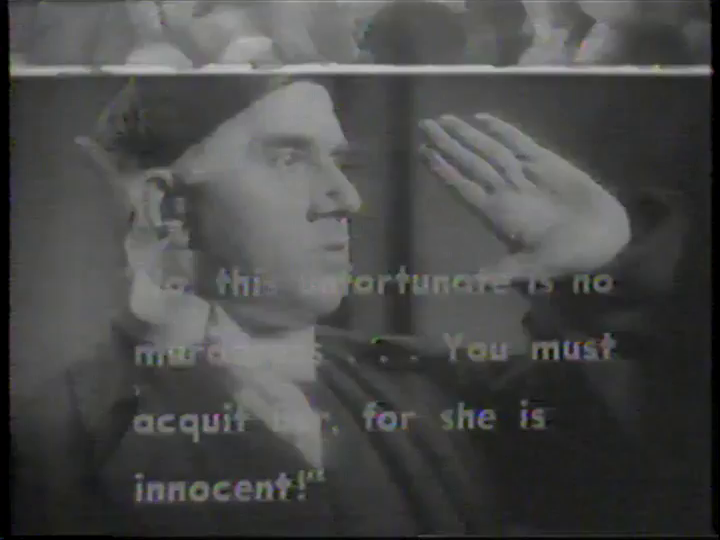
|
|
By the way, in case you’re curious, the 16mm print from 1974, 110 minutes at 24fps,
had a few editing and translation corrections, and it had a piano score by Curtis Ivan Salke.
The VHS edition from Embassy Home Entertainment in 1988 had a piano score by Stuart Oderman.
Neither was a thousandth as good as Bill Perry’s score.
For what it’s worth, Salke’s score has never been issued on video.
The only way to hear it is to get that 16mm print, if it still exists.
|
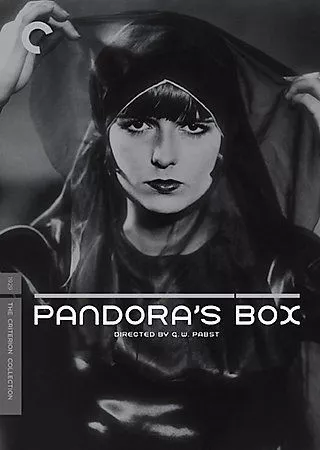 Criterion DVD, 2006 |
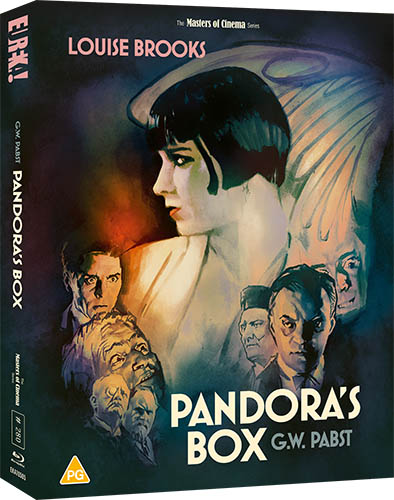 Eureka Blu-ray, 2023 |
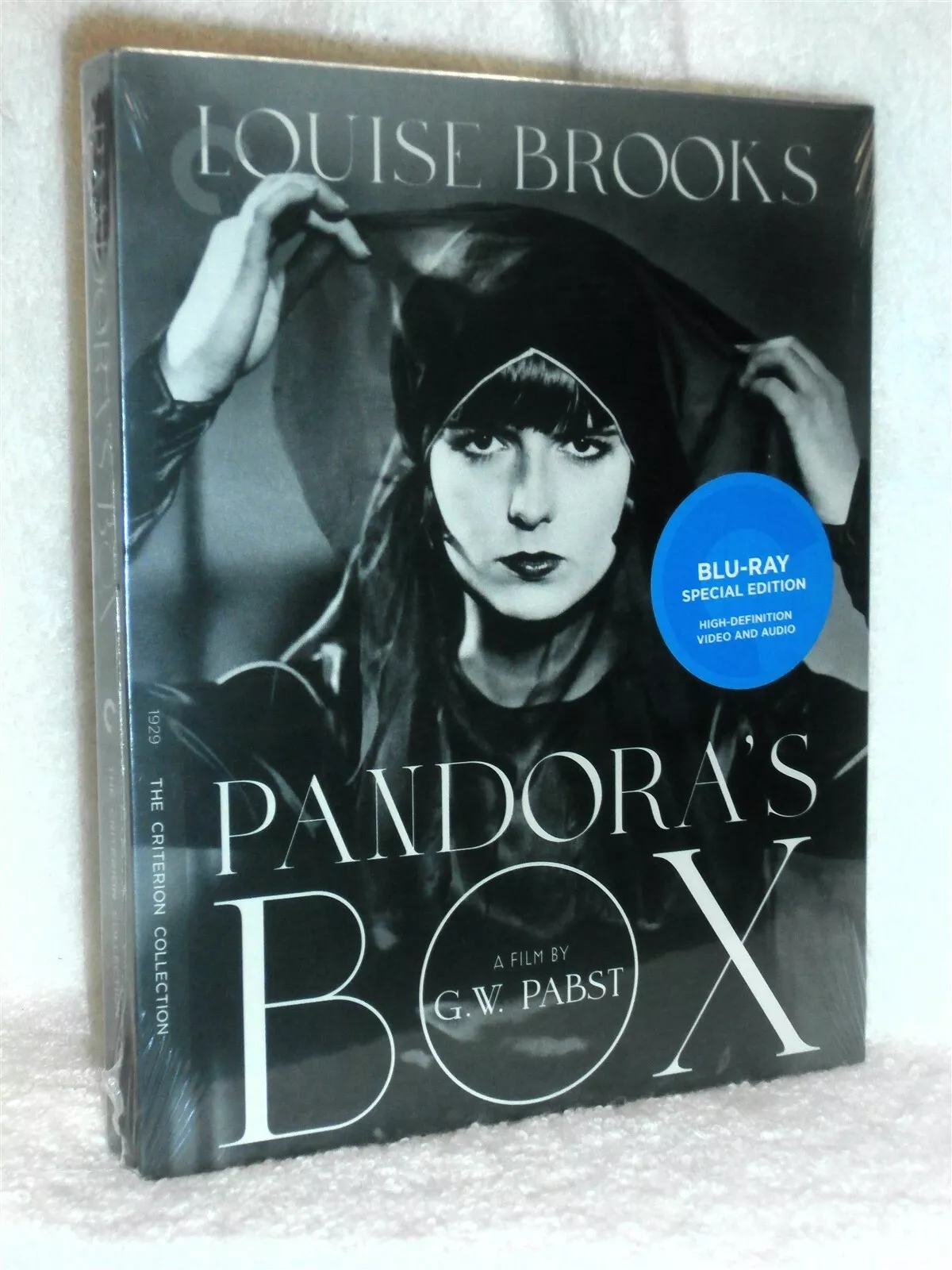 Criterion Blu-ray, 2024 |
 Criterion DVD, 2024 |
|
If you’re looking for an image of better quality,
you can get the Criterion 358 DVD from 2006.
The Eureka “Masters of Cinema” # 280 EKA70505
|
|
The other scores on video don’t do much for me.
Two of the four scores on the Criterion DVD are passable but nothing more.
The other two, well....
I purchased the Tartan Video VHS, issued in the UK in 1993, 25fps,
just so that I could check out the musical score.
Well, there isn’t one.
It is completely mute, but the liner notes suggest that we put on some Tangerine Dream while watching the movie.
Or The Orb.
Or Bernard Herrmann.
Thanks guys. Very helpful. Not.
And it’s from a dark, dupey, flickery print with gobs of jitter and weave, probably a 16mm bootleg.
Worthy of nothing more than the garbage bin.
I once heard an accompaniment to Pandora’s Box by a trio —
piano, violin, French horn (the program notes say piano, guitar, and trumpet, and so my memory must be at fault) —
playing the same several seconds of agonizingly discordant noise over and over and over and over and over and over again,
for two and a half hours.
The trumpet sounded like a whale moaning in agony
as it was being tortured to death by the other two instruments,
which ceaselessly took turns picking through its flesh with a chisel.
They totally killed the movie.
And I wanted to kill the musicians.
Most of the audience politely stood and applauded when the abomination was over,
and that was one of the most offensive spectacles I have ever witnessed.
It would have been better had there been no accompaniment at all.
Had I not been there as part of a group of four who drove me there and back, I would have walked out.
As for the other three in our group, they had never seen the movie before and they absolutely despised it.
Two of them soon fell asleep out of oppressive boredom.
That awful racket killed the film, killed it dead.
That horrid endless-loop wailing transformed a captivating, beautiful movie into an ugly endurance test.
As that repetitious cacophony continued, I wanted to scream out,
“SHUT OFF THAT NOISE ALREADY!!!!! SHUT UP!!!!! STOP IT!!!!!”
That is when I decided never again to attend a silent film unless I am assured that the accompaniment
will be by musicians who have been trained in silent cinema and who know what they’re doing
and who are not using the opportunity to show off.
I am so lucky, so so so so so so lucky, that my introduction to Pandora’s Box was via Bill Perry, not via that trio.
I grieve for all the people who were introduced to the movie through that trio.
|
|
By the time high-intensity carbon-arc lamphouses were installed in the deluxe cinemas in 1920–1923,
|
 https://youtu.be/I_lqtFtB63s Click on the above image to watch the video. When YouTube disappears this video, download it. |
|
The above was shown at the
Borderlines Film Festival
on
Sunday, 7 March 2015, 6:15pm, at The Courtyard in Hereford.
As projectionist Simon Nicholls confesses in the note beneath the YouTube video,
he ran it with the Academy 1:1.375 aperture (.600"×.825") rather than the full 1:1.33 silent aperture (.6796"×.90625").
Why?
I’ll tell you why.
Because his owners did not deem it worth the bother to purchase the correct aperture or the appropriate longer lens to accommodate.
That’s why.
To compensate somewhat, he inserted the aperture only part way in order to have a crop that was centered.
Actually, it is amazing that a modern cinema had even the 1:1.375 setup.
That was exceedingly rare, and nearly every cinema on earth would have cropped the image much, much, much more than that.
Look at the booth setup!
A single machine with all six reels spliced together onto a gigantic outboard reel,
and the film had to go through torturous winding paths.
Bad in every way.
Now that film prints are rare, they should all be treated as archival.
Chopping off leaders and tails to splice all the reels onto larger reels should be verboten.
Such assemblies damage the film.
The winding path doesn’t faze projectionists, except for this particular one.
Triacetate and diacetate films are all brittle and getting brittler.
A winding path, as I have personally experienced, can rip a brittle film to shreds.
There is more.
The machine was slowed down to 20fps, or 75'/min.
Pandora’s Box can be slowed down that much, and it looks fine that way,
but it was never shown that way originally and 21fps would be more authentic.
As Simon further confesses:
“Trial and error dictated 20fps was about right for the pianist without too much flicker.”
Yikes!
If you’re gonna slow it down to 20fps, you need to install three-wing shutters or,
better yet, just drop a filter in front of the lens to darken the image slightly.
That eliminates objectionable strobe (it’s strobe, not flicker),
and no matter which method is used the result looks identical, as far as the human eye can discern.
Instead, he just ran it with the normal setup but slowed down, resulting in more strobe, though, he says, not “too much.”
Ach, Mein Gott in Himmel! Wrong, wrong, wrong, wrong, wrong.
This is how things are done at a festival?????
Festival presentations are supposed to be flawless.
There should be no compromises whatsoever.
What has the world come to?
Why do I almost never go to movies anymore?
This is why.
Except in the rarest venues, rare venues that are getting rarer by the month, the presentations are all ruined.
I would rather not see a movie at all than see it massacred.
|
|
Once again, I am going to be tiresome, even though I have discovered that NOBODY cares a fig about this atrocity:
|
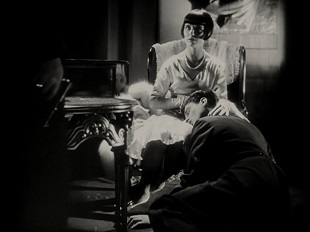 Silent |
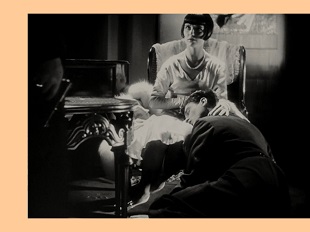 Cropped to Academy sound format |
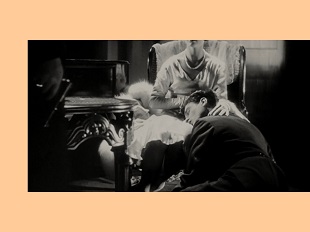 Cropped to widescreen |
 Silent |
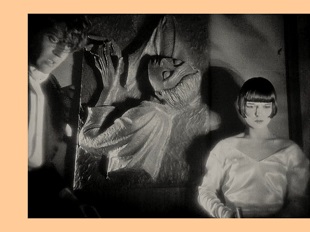 Cropped to Academy sound format |
 Cropped to widescreen |
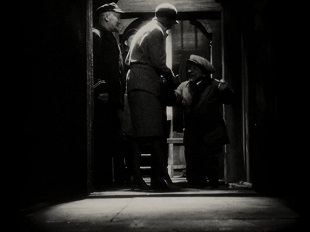 Silent |
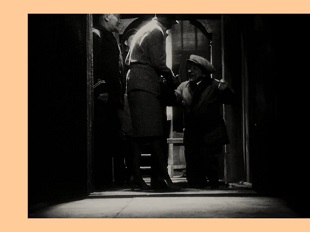 Cropped to Academy sound format |
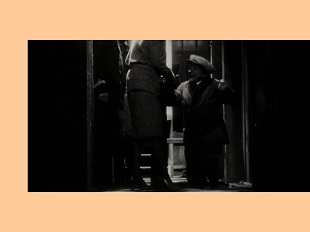 Cropped to widescreen |
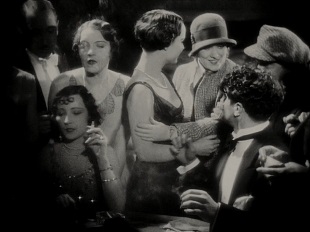 Silent |
 Cropped to Academy sound format |
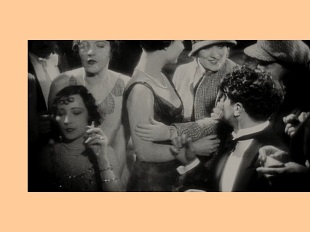 Cropped to widescreen |
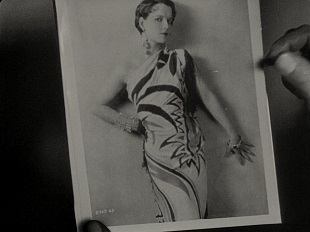 Silent |
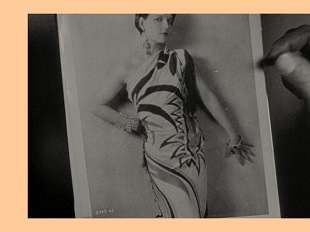 Cropped to Academy sound format |
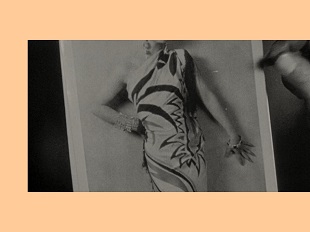 Cropped to widescreen |
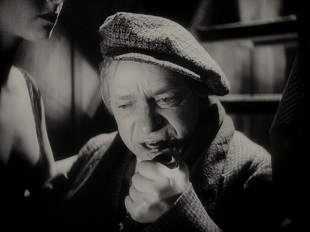 Silent |
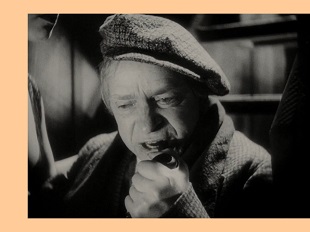 Cropped to Academy sound format |
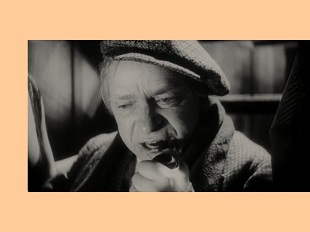 Cropped to widescreen |
 Silent |
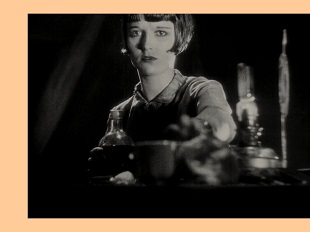 Cropped to Academy sound format |
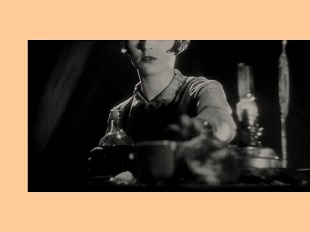 Cropped to widescreen |
|
Nobody cares. Nobody. Nobody.
Except for me.
I am the only one who cares.
And nobody understands why I care.
People get fed up with me for griping about this.
When people ask why I didn’t attend a silent movie I really wanted to see,
I tell them that this is the reason, and they sigh in exasperation and walk away, done with me forever.
“Picky, picky, picky.”
|
|
Ah!
Click here for an article
that tells us what sources still survive on this film.
Nothing original survives.
Only three much-later copies have been passed on to us.
That confuses me completely.
|
|
Below is what little I have been able to dig up about the distribution/exhibition history.
Just after I did the bulk of this research,
I discovered that I am not the first person to plough into this.
Thomas Gladysz
beat me to the punch by a full five years,
and then he beat me to the punch again
by a month and a half!
|
|
Moviegraphs, Inc.
154 West 55th Street Manhattan NY |
|
According to IMDb, the US distributor in 1929 was
Moviegraphs,
a very small firm that seems to have lasted only a few years.
We learn more from Mordaunt Hall
in the New York Times of 21 May 1927:
|
|
THE SCREEN
The first motion picture theatre built specially
for the furtherance of the intelligent motion pictures was opened last night.
It seats 260 persons and is called the Fifty-fifth Street Cinema,
and is in Fifty-fifth Street just east of Seventh Avenue.
In other days the structure was the scene of livery and horses.
It is tastefully decorated.
The Art Cinema League, as it is called, sponsors this new place of entertainment.
The guiding spirits are M. M. Maiman, H. D. Dubiner and Robert I. Powell.
Mr. Maiman has been connected with the motion picture business as the head of Moviegraphs, Inc.
Mr. Dubiner is a wholesale diamond dealer in this city and Mr. Powell is an architect.
The features of the new strutcure that attract the eye are the fine oak ceiling and the artistic proscenium arch.
It is set forth on the program that this new picture theatre will
“be devoted to the intellect and the esthetic emotions,
rather than the cheap sentimentalities and banal melodramatics.”...
Samuel Kramer, violinist.
|
|
Was M.M. Maiman the same as Max Milton Maiman, born in NYC on 12 July 1897?
Was he the same as Max Maiman, died in NYC on 11 October 1951?
Note the name of H.D. Dubiner(!!!!!).
Dubiner was one of those Ellis Island transmogrifications.
The name was originally Dubinski.
This might prove an invaluable lead!
Oh my oh my oh my, I need to learn more about this!
More info comes from Tony Guzman,
“The
Little Theatre Movement: The Institutionalization of the European Art Film in America,”
Film History: An International Journal, vol. 17 nos. 2/3 (2005), pp. 261–284,
published by Taylor & Francis.
Shall we examine the relevant portions of the text?
|
|
On 20 May 1927 another
The Art Cinema
League brought in Symon Gould from the Film Arts
Guild to take over programming in an effort to compete
better with its two stronger rivals, but the 55th
Street Cinema continued to struggle for films and
patrons.
By 3 October 1927, after months of poor to
mediocre business, the self-proclaimed ‘Sanctuary
of the Cinema’ fired much of its staff and replaced
Gould with Jay David Blaufox who, contrary to the
statement of purpose delivered in May, inaugurated
a policy of showing any ‘great’ film regardless of
whether it was ‘art’ or not.
At the beginning of 1928 Michael Mindlin’s
Fifth Avenue Playhouse Group, Inc., was the dominant
figure in the little theatre movement....
Mindlin reached the pinnacle of his success in
January 1928 when he finally succeeded in vanquishing
the 55th Street Cinema. In little more than
seven months the 55th Street Cinema had lost
$84,000 with the result that the theatre owners closed
the theatre, fired Jay David Blaufox and his staff, and
brought in Mindlin to run it. Mindlin changed the
theatre's name to the 55th Street Playhouse and
reopened the theatre on 17 February 1928 with the
national premiere of Der Kampf des Donald Westhof
(The Trial of Donald Westhof, 1927). Mindlin's management
team quickly turned around the 55th Street
Playhouse’s profitability with their ability to book
better films and superior showmanship. The Fifth
Avenue Playhouse Group now enjoyed near total
dominance of New York’s art film market.
Mindlin’s good fortune ended that summer as
he suffered a series of reversals that reduced his
empire abruptly to a single theatre....
In New York his expansion plans cost him the
55th Street Playhouse. In August, Mindlin took out a
lease on a former night club, ‘Le Perroquet’, on 146
West 57th Street in the same general area as the 55th
Street Playhouse. On this site Mindlin began to create
the Little Carnegie Playhouse, the most luxurious
and modern little theatre in the country. Mindlin secured
the property by agreeing to a rental of $21,000
per year as well as sharing 25 per cent of the net
profits with the property owner, Otto H. Kahn. Not
surprisingly the owners of the 55th Street Playhouse
took a very dim view of the conflict of interest in
Mindlin building an opposition theatre in the same
district as the theatre he was managing for them.
They fired Mindlin in September 1928 and hired away
his valuable aide, Joe Fliesler, to manage the 55th
Street Playhouse....
Mindlin’s former employee Joseph Fliesler
had in the meantime succeeded in completely reversing
the 55th Street Playhouse’s fortunes. The
Playhouse had been a financial disaster prior to its
acquisition by Mindlin in early 1928. Under Mindlin’s
direction for most of the 1928, the Playhouse’s business
improved somewhat, losing only $25,000 for
the year. However under Fliesler’s first full year of
directorship, the Playhouse actually turned a profit of
$5,000 in 1929. It was a remarkable turnaround for
a theatre that had seemed destined for failure....
|
|
Moviegraphs, Inc., must have ordered several prints from Nero Films A.G. in Berlin.
As each print was submitted to a local censor board prior to each booking,
the local censor board ordered massive cuts.
I can find only six bookings, three of them in NYC.
So there were likely four prints at minimum, likely five.
I can only assume that Moviegraphs kept at least one uncut print for reference.
Or could it have been that Moviegraphs did not order prints,
but instead ordered a lavender or a copy negative,
from which it could make as many prints as it needed?
What happened to all these prints?
Were they all returned to Berlin?
Or were they chemically dissolved when the license expired?
|
|
Thomas Gladysz wrote a wonderful article on the topic,
in which he provided a bit of information about the various international releases.
See it at
“‘Sin Lust Evil’ in America:
Louise Brooks and the Exhibition History of Pandora’s Box (1929),”
filmint Online: Thinking Film Since 1973, 23 April 2023.
|
|
Probably never played in Australia, though we see that it did get a bit of publicity
in anticipation of a release:
|
|
Apparently, there was a Manhattan press screening for critics only,
and it almost certainly occurred right at the end of October 1929 at the 55th Street Playhouse.
To all appearances, this was a complete print as received from Nero Films A.G.
What appeared on screen once the local censors ran it through their lawnmower
was only about
|
|
The scheduled opening day:
|
|
The advertised closing day:
|
|
Actually, I am quite certain that it did not play at all.
It was scheduled and advertised, but the censor board killed it.
Perhaps the 55th Street Playhouse went dark these two days?
|
|
Why was Pandora’s Box censored?
There is not a single objectionable image in it.
There is not a single objectionable word in it.
Vajda and Pabst kept it all as inoffensive as possible.
The problem was with the story and the characters:
a hooker, a pimp,
|
|
Every copy of this movie that I have ever seen misspells Alice Roberte as Alice Roberts.
I see this problem goes back to December 1929! Please pay attention to the German poster above.
This is what you see:
|
|
Also, the French poster:
|
|
You still disbelieve me, so here’s an autographed photo as listed by Wittenborn Art Books of San Francisco:
|
|
And from Cyranos.ch:
|
|
So there.
|
|
|
Pandora’s Box also received probably a single British booking,
at a small cinema that did not advertise, and so we cannot ascertain precisely when the movie was shown.
We are also in the dark about which company distributed it.
|
|
Thomas Gladysz includes the above ad in his essay,
surely from 15 May 1931 and surely from somewhere in New Jersey,
but I have searched high and low for it and can find it nowhere,
not in ProQuest, not in Newspapers.com, not in NewspaperArchive.com, not in GenealogyBank.com, not in Google Newspapers,
not in Chronicling America, not in Google Books, not in Archive.org,
not in Old Fulton Postcards.
I cannot figure out how he found this, unless, perchance, he did it the
|
|
Or was it a preposterous claim?
A critic whose initials were “R.H.” wrote in
“The Week on the Screen: Three Silent Films,” The Guardian, Saturday, 19 April 1930, p. 8:
“I had no idea when I wrote last week of
Pabst’s ‘Lulu,’ that it would be
trade shown so soon. It was rumoured that it
was being synchronized, but it was shown
silent last week under its original title of
‘Pandora’s Box’....”
Okay. Whatever. This R.H. also wrongly supplied Alice’s surname as Roberts.
Here are R.H.’s two reviews dealing with Lulu, or Pandora’s Box:
|
|
We can discern from what R.H. wrote that he (almost certainly a he)
had previously seen a more authentic edition, surely in Germany.
I have no idea who the British distributor was,
though I can only assume that Nero sent the British distributor the
|
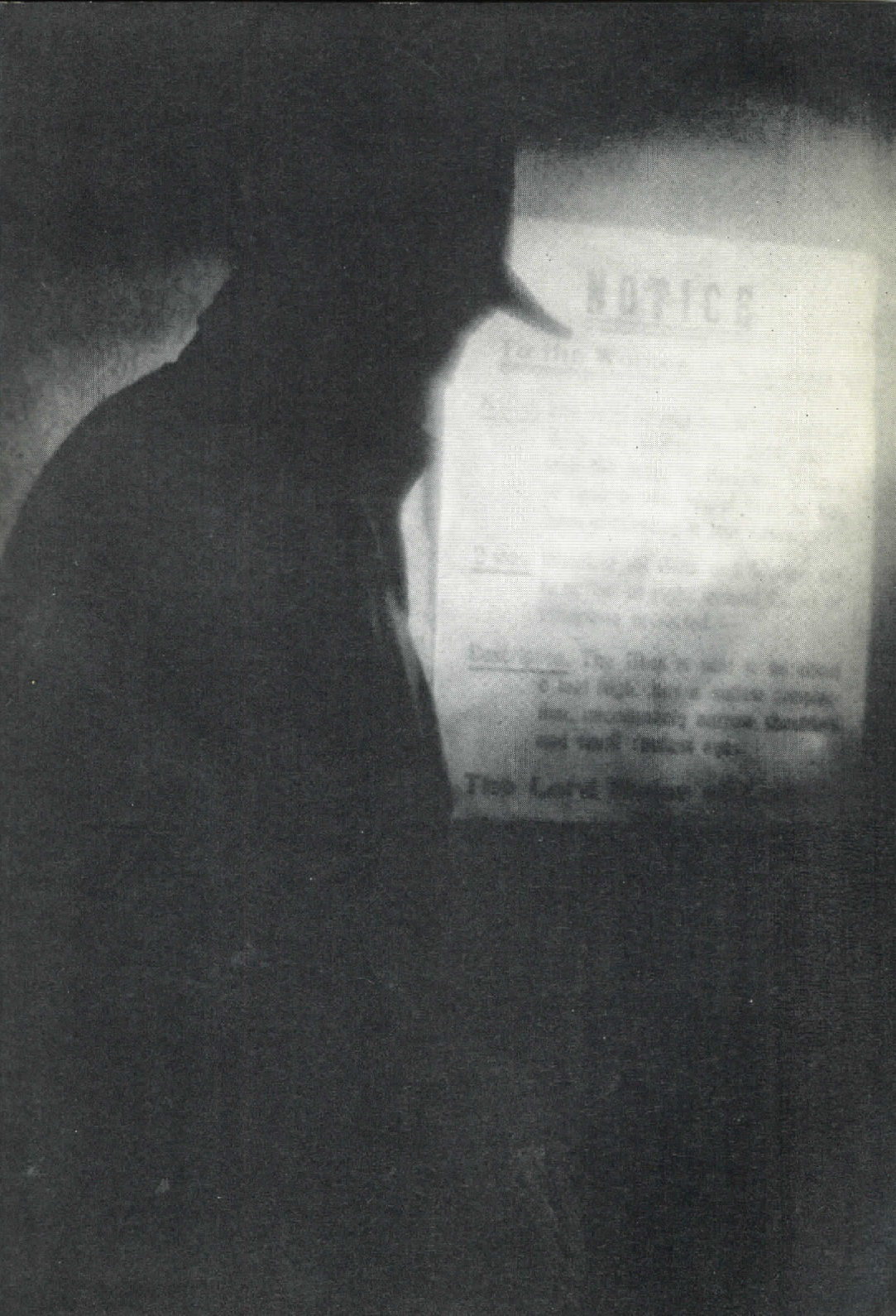
|
|
Zo, let us summarize.
The only English-language bookings that I can find are:
|
| ca. Thu 31 Oct 1929 | 55th Street Playhouse (press screening) | Manhattan NY |
| 55th Street Playhouse (CANCELED) | Manhattan NY | |
| Sat 30 Nov 1929 – Fri 13 Dec 1929 | 55th Street Playhouse | Manhattan NY |
| Wed 01 Jan 1930 | Little (press screening) | Baltimore MD |
| Sun 26 Jan 1930 – Sat 01 Feb 1930 | Little | Baltimore MD |
| ca. 14 Apr 1930 | [unknown] (trade screening) | London, England |
| Sat 10 May 1930 – Fri 16 May 1930 | Acme | Manhattan NY |
| ca. 24 Aug 1930 | Gaiety Picture Palace | London, England |
| Sat 16 May 1931 – Fri 22 May 1931? | Little | Newark NJ |
| Tue 05 Dec 1933 – Thu 07 Dec 1933 | Fifth Avenue Theatre | Manhattan NY |
| Sun 29 Apr 1934 (only) | The Playhouse at Taliesin | Madison WI |
|
That was it. The movie was a boxoffice dud.
Nobody knew about it, and nobody cared.
It was as dead as a doornail.
It disappeared, unknown, entirely forgotten.
When that happens to a movie, it remains forgotten forever.
In this case, though, it was forgotten only for 26 years.
Then a miracle happened, and, almost overnight,
it became one of the most famous movies in all cinema history.
|
|
It must have been in 1955 that Henri Langlois revived Pandora’s Box
at the Cinémathèque française in Paris.
Why did he do that?
Alas, here I need to rely upon my extremely faulty memory about a story that Jim Card told.
My memory is that Jim repeatedly begged Henri for a screening of Diary of a Lost Girl,
which he had never seen and which was in the Cinémathèque’s collection.
Henri scoffed at the idea, proclaiming that the film could not possibly be of any interest whatsoever.
Yet at last he gave in to Jim’s entreaties and the two watched it together.
The film was incomplete and ended abruptly when Fritz Rasp got his face slapped,
which meant it was missing about the last three reels.
Langlois, initially hostile to the film, was bowled over and proclaimed that Louise was the best actress ever.
He then retrieved Pandora’s Box and projected that as well.
That must have been when Jim first saw either film, as neither had been available anywhere.
|
|
Langlois, maddeningly, insisted that silent films all be shown at exactly 16fps without any musical accompaniment.
Brutal torture!
It would be unendurable at 16fps.
In a just world, showing a silent film to a paying audience
without providing appropriate musical accompaniment would be a capital offense.
|
|
Just afterwards, Jim Card of the Eastman House learned Louise’s whereabouts
and convinced her to move to Rochester and write a memoir.
|
|
|
In 1957
Jim Card revived
three of Louise’s movies at the Dryden screening room at the Eastman House in Rochester:
Love ’Em and Leave ’Em, Diary of a Lost Girl, and Prix de beauté.
Apparently there is a widespread belief that Pandora’s Box was shown as well,
in June 1958, but I have gone through the newspaper listings for all of 1958 and cannot find it.
The Eastman House presented one movie each weekend, once on Saturday, repeated on Sunday.
I do not see Pandora’s Box listed anywhere.
I do, though, find a listing for Diary of a Lost Girl on
Saturday/Sunday, 21/22 June 1958. Shall we look a bit more closely?
|
|
Sat, 03 May 1958, “free movies” [no title mentioned]
Sun, 04 May 1958, “movies” [no title mentioned] Sat, 10 May 1958, “free movies” [probably The Brothers Karamazov] Sat, 11 May 1958, The Brothers Karamazov Sat, 17 May 1958, “free movies” [no title mentioned] Sun, 18 May 1958, “films” [no title mentioned] Sat, 24 May 1958, The Outcasts a/k/a Slums of Berlin Sun, 25 May 1958, The Outcasts a/k/a Slums of Berlin Sat, 31 May 1958, Sparrows Sun, 01 Jun 1958, Sparrows Sat, 07 Jun 1958, Port of Shadows Sun, 08 Jun 1958, Port of Shadows Sat, 14 Jun 1958, Tess of the Storm Country Sun, 15 Jun 1958, Tess of the Storm Country Sat, 21 Jun 1958, Diary of a Lost Girl Sun, 22 Jun 1958, Diary of a Lost Girl Sat, 28 Jun 1958, free movies (title not listed, but probably Vampyr) Sun, 29 Jun 1958, Vampyr Sat, 05 Jul 1958, Twentieth Century Sun, 06 Jun 1958, Twentieth Century Sat, 12 Jul 1958, The Yellow Cruise, film of the Asiatic expedition Sun, 13 Jun 1958, The Yellow Cruise Sat, 19 Jul 1958, Things to Come Sun, 20 Jun 1958, Things to Come Sat, 26 Jul 1958, The Wedding of Palo Sun, 27 Jun 1958, The Wedding of Palo |
|
Then, inexplicably, the movie began popping up again.
The BFI somehow got some sort of print of some edition of it from somewhere
and presented it at the National Film Theatre in London in May 1957.
The published shooting script, in English translation,
appeared from Lorrimer (London) and Simon & Schuster (NY) in 1971.
“Square brackets and footnotes denote the parts of the script
that did not appear in the print of the film available for viewing.”
What print of the film was available for viewing?
The BFI’s print.
What else can we learn about the BFI print?
Nothing until the
BFI’s website begins to function again.
Oh, wait, miracle.
It opened:
|
|
Insufficient information, but we can learn a little.
At the bottom we see catalogue number
|
|
Can’t remember where, but, many moons ago,
I read an interview with Louise in which she insisted that the original film could only have been about 89 or 90 minutes long;
she further rejected any claims that it was ever any longer than about 90 minutes.
She was wrong.
Current prints are 110 minutes (at 24fps, longer if slowed down, as they often are),
and so that’s about 9,900 feet.
The original release records indicate that it was 3,254m, which is about 10,676 feet,
which is about 8 minutes longer (at 24fps) than the version we have now.
|
|
Stranger yet, the movie played at UCLÁ’s Royce Hall in June 1962.
Where did the print come from?
What edition was it?
|
|
Apparently, the Cinémathèque française
and the BFI continued to revive Pandora’s Box with some regularity.
As the Marylebone and Paddington Mercury of Friday, 27 November 1964 (p. 6) asserted:
“Whenever the film has been
revived at the National Film
Theatre and in Paris, it has
drawn capacity houses. Louise
Brooks emerged from retirement
to find herself a legend.”
(See also this.)
|
|
There is no listing that I can find anywhere,
but the article below confirms that Pandora’s Box
was indeed presented at the Eastman House’s Dryden screening room
on Monday, 12 July 1965, with Louise herself as guest of honor.
Of course, Jim, as always, insisted on running all silent films at 24fps,
because that’s how he remembered movies being presented when he was a kid in the 1920’s.
He didn’t seem to understand that, prior to 1922, 24fps was way too fast for most movies.
He also seemed not to understand that many foreign films did not follow Hollywood practice,
and so they need to be slowed down a bit.
Yes, I had this conversation with him, and it got, well, complicated.
Not heated, but complicated.
In my opinion, Pandora’s Box looks horrible at 24fps.
It looks great at 21fps. In my opinion.
How I wish I knew Pabst’s preference!
(After Jim retired, the Dryden finally installed variable speed in, I think, 1991, but made a total mess of it.
A decade or so later they finally worked out the bugs.)
This 12 July 1965 screening is the one that Louise mentioned in her September 1965 article,
“Pabst and Lulu,” originally published in Sight and Sound
and later reprinted in the brochure that accompanied the 2006 Criterion DVD set
as well as in the 2024 Criterion
|
|
By 1967, the BFI must have been loaning out a print, likely 16mm,
for we discover that the Bristol Arts Centre presented the film in
June 1967.
|
|
A year later, we discover that the Cinémathèque canadienne in Montréal
presented the film on
Friday, 4 October 1968.
Where did this come from?
Was it a 16mm print from the BFI’s distribution library?
|
|
It then popped up again, at a members-only cinema, the Tyneside Cinema Two, on Sunday, 30 November 1969:
Presumably this was a BFI 16mm circulating print:
|
|
And at the Newport Film Theatre in Newport, Gwent, Wales, on Wednesday, 1 April 1970:
|
|
It was sometime in 1971 that Lorrimer in London and Simon & Schuster in New York
issued a heavily
|

|
|
The Pacific Film Archive in Berkeley, on Thursday, 5 October 1972:
|
|
Then there was this promising series from the MoMA library,
promised for the War Memorial Center at the Milwaukee Art Center,
but I don’t think it ever happened, as one by one each film was canceled.
Pandora’s Box was scheduled for
Thursday, 26 October 1972, but it went phffft.
|
|
Janus Films somehow licensed the rights seemingly in the early 1970’s,
and that may or may not have been from the BFI, as it was allegedly 89 minutes.
Information is scarce.
Or maybe that never happened?
In 1973, Janus licensed the rights to a preliminary reconstruction,
on which Jim Card must have served as a consultant.
How do I know?
Because Jim praised Pabst’s brilliance at never inserting titles in the middle of shots.
Of course, Jim was wrong, as Pabst most certainly did insert titles in
|
|
Whatever version or versions of Pandora’s Box Janus offered,
the movie was being shown, somewhere, here and there,
and so members of film clubs as well as university students got to see it,
and it was also booked here and there at museums and at commercial cinemas.
So a few Americans were discovering it. Very few.
|
|
These revivals led to other revivals.
Those revivals also got people to talking about a movie that absolutely NOBODY would otherwise have known about.
|
|
Walker Art Center auditorium, Minnapolis, 11 June 1974:
|
|
Edmonton Art Gallery Cinema, Thursday, 11 December 1975:
|
|
MoMA, Sunday, 7 November 1976:
|
|
El Rey, San Francisco, Tuesday, 29 March 1977:
|
|
OISE Ontario Institute for Studies in Education, Toronto, Thursday, 5 January 1978:
|
|
The second Eastman House/Dryden showing that I can find of Pandora’s Box was
Friday, 15 December 1978.
It was immediately preceded by the below article:
|
|
Thomas Gladysz did a little bit of newspaper digging, and that inspired me to do the same.
|
|
WNET/13 in Manhattan licensed “PBS Movie Theater” but chopped off the series opening
and instead rolled the movies into its own established series, “Cinema 13.”
The WNET signal covered not only New York City but also much of New Jersey and Connecticut and
at least as far up north as Poughkeepsie and at least as far down south as Philadelphia.
|
|
Enough already. I’m tired of all these capturoos.
Here follows a simple list of the broadcasts I was able to trace down.
Because TV listings insist that midnight ends the day rather than begins it,
I have indicated this as 24:00 rather than 00:00.
|
| DATE | TIME | STATION | CITY | SERIES |
| Fri 20 May 1977 | 24:00 | WNET/13 | Manhattan NY | Cinema 13 |
| Thu 09 Jun 1977 | 21:00 | WSIU/8 | Carbondale IL | ? |
| Thu 09 Jun 1977 | 21:00 | WUSI/16 | Olney IL | ? |
| Mon 13 Jun 1977 | 23:00 | WGBH/2 | Boston MA | ? |
| Mon 18 Jul 1977 | 14:00 | WNET/13 | Manhattan NY | Cinema 13 |
| Mon 18 Jul 1977 | 14:00 | WETA/26 | Washington DC | Cinema 26 |
| Wed 21 Sep 1977 | 23:00 | KLRN/9 | Austin & San António TX | PBS Movie Theater |
| Sat 22 Oct 1977 | 21:00 | WGBY/12 | Springfield MA | PBS Movie Theater |
| Sat 22 Oct 1977 | 21:00 | WGBY/57 | Springfield MA | PBS Movie Theater |
| Wed 16 Nov 1977 | 14:00 | WETA/26 | Washington DC | Cinema 26 |
| Sat 24 Dec 1977 | 21:00 | KFME/13 | Fargo ND | ? |
| Sat 24 Dec 1977 | 22:00 | KISU/10 | Pocatello ID | ? |
| Sat 24 Dec 1977 | 21:00 | KLRN/9 | Austin & San António TX | PBS Movie Theater |
| Sat 24 Dec 1977 | 22:00 | KNME/5 | Albuquerque NM | PBS Movie Theater |
| Sat 24 Dec 1977 | 22:00 | KQEH/54 | San José CA | ? |
| Sat 24 Dec 1977 | 23:00 | KSPS/7 | Spokane WA | ? |
| Sat 24 Dec 1977 | 24:00 | KTCA/2 | Minneapolis MN | PBS Movie Theater |
| Sat 24 Dec 1977 | 22:00 | KUED/7 | Salt Lake UT | PBS Movie Theater |
| Sat 24 Dec 1977 | 22:00 | KVIE/6 | Sacramento & Stockton CA | PBS Movie Theater |
| Sat 24 Dec 1977 | 22:00 | KVIE/12 | Sacramento & Stockton CA | PBS Movie Theater |
| Sat 24 Dec 1977 | 22:00 | KYW/3 | Philadelphia PA | PBS Movie Theater |
| Sat 24 Dec 1977 | 22:00 | WABW/14 | Pelham GA | ? |
| Sat 24 Dec 1977 | 22:00 | WBRA/15 | Roanoke VA | PBS Movie Theater |
| Sat 24 Dec 1977 | 22:00 | WCBB/10 | Augusta ME | ? |
| Sat 24 Dec 1977 | 22:00 | WCES/20 | Wrens GA | ? |
| Sat 24 Dec 1977 | 22:00 | WCML/6 | Alpena MI | PBS Movie Theater |
| Sat 24 Dec 1977 | 22:00 | WEDH/24 | Hartford CT | PBS Movie Theater |
| Sat 24 Dec 1977 | 22:00 | WEDU/3 | Tampa FL | PBS Movie Theater |
| Sat 24 Dec 1977 | 22:00 | WEDW/49 | Stamford CT | ? |
| Sat 24 Dec 1977 | 22:00 | WENH/11 | Durham NH | PBS Movie Theater |
| Sat 24 Dec 1977 | 22:00 | WFYI/20 | Indianapolis IN | PBS Movie Theater |
| Sat 24 Dec 1977 | 22:00 | WGTV/8 | Athens GA | ? |
| Sat 24 Dec 1977 | 22:00 | WHYY/12 | Wilmington DE | PBS Movie Theater |
| Sat 24 Dec 1977 | 22:00 | WJSP/8 | Columbus GA | ? |
| Sat 24 Dec 1977 | 22:00 | WKPC/15 | Louisville KY | PBS Movie Theater |
| Sat 24 Dec 1977 | 22:00 | WKPO/15 | Knoxville TN | ? |
| Sat 24 Dec 1977 | 21:00 | WLPB/27 | Baton Rouge LA | PBS Movie Theater |
| Sat 24 Dec 1977 | 22:00 | WMFE/24 | Orlando FL | ? |
| Sat 24 Dec 1977 | 21:00 | WNIN/9 | Evansville IN | ? |
| Sat 24 Dec 1977 | 22:00 | WNJS/23 | Camden NJ | PBS Movie Theater |
| Sat 24 Dec 1977 | 22:00 | WQEX/16 | Pittsburgh PA | PBS Movie Theater |
| Sat 24 Dec 1977 | 22:00 | WQLN/54 | Erie PA | ? |
| Sat 24 Dec 1977 | 21:00 | WSRE/23 | Pensacola FL | PBS Movie Theater |
| Sat 24 Dec 1977 | 22:00 | WTIU/30 | Bloomington IN | ? |
| Sat 24 Dec 1977 | 22:00 | WUFT/5 | Gainesville FL | ? |
| Sat 24 Dec 1977 | 22:00 | WVAN/9 | Pembroke GA | ? |
| Sat 24 Dec 1977 | 22:00 | WVPT/51 | Harrisonburg VA | PBS Movie Theater |
| Sat 24 Dec 1977 | 21:00 | WYES/12 | New Orleans LA | PBS Movie Theater |
| Sun 25 Dec 1977 | 20:00 | KQEC/32 | San Francisco CA | ? |
| Sun 25 Dec 1977 | 21:00 | WGBX/44 | Boston MA | ? |
| Sun 25 Dec 1977 | 12:30 | WHYY/12 | Wilmington DE | PBS Movie Theater |
| Mon 26 Dec 1977 | 22:30 | WSIU/8 | Carbondale IL | ? |
| Mon 26 Dec 1977 | 22:30 | WUSI/16 | Olney IL | ? |
| Tue 27 Dec 1977 | 20:00 | WLIW/21 | Garden City NY | ? |
| Tue 27 Dec 1977 | 23:30 | WVIA/44 | Scranton PA | PBS Movie Theater |
| Wed 28 Dec 1977 | 21:30 | KVDO/3 | Salem OR | ? |
| Wed 28 Dec 1977 | 13:30 | KVIE/6 | Sacramento & Stockton CA | PBS Movie Theater |
| Sat 31 Dec 1977 | 23:30 | KERA/13 | Dallas TX | ? |
| Sat 31 Dec 1977 | 14:00 | KTCA/2 | Minneapolis MN | PBS Movie Theater |
| Sat 31 Dec 1977 | 22:00 | KUHT/8 | Houston TX | PBS Movie Theater |
| Sat 31 Dec 1977 | 22:00 | KVPT/18 | Fresno CA | PBS Movie Theater |
| Sat 31 Dec 1977 | 23:30 | WGTV/8 | Athens GA | The Foreign Film II |
| Sat 31 Dec 1977 | 23:30 | WPBT/2 | Miami FL | ? |
| Sat 31 Dec 1977 | 14:00 | WPTD/16 | Dayton OH | PBS Movie Theater |
| Sun 01 Jan 1978 | 15:00 | WNED/17 | Buffalo NY | PBS Movie Theater |
| Fri 06 Jan 1978 | 20:00 | KHET/4 | Hilo HI | PBS Movie Theater |
| Fri 06 Jan 1978 | 20:00 | KHET/11 | Honolulu HI | PBS Movie Theater |
| Fri 06 Jan 1978 | 20:00 | KMEB/10 | Wailuku HI | PBS Movie Theater |
| Sat 07 Jan 1978 | 24:00 | KAET/8 | Phoenix AZ | ? |
| Sun 08 Jan 1978 | 13:00 | KCET/28 | Los Ángeles CA | ? |
| Mon 09 Jan 1978 | 24:00 | KAET/8 | Phoenix AZ | ? |
| Sun 05 Feb 1978 | 15:00 | WNED/17 | Buffalo NY | PBS Movie Theater |
| Fri 05 May 1978 | 14:00 | WETA/26 | Washington DC | Cinema 26 |
| Sat 24 Jun 1978 | 19:00 | WILL/12 | Urbana IL | ? |
| Sun 10 Sep 1978 | 13:00 | KLTM/13 | Monroe LA | Silver Screen |
| Sun 10 Sep 1978 | 22:00 | KLTM/13 | Monroe LA | Silver Screen |
| Sun 10 Sep 1978 | 22:00 | KLTS/24 | Shreveport LA | Silver Screen |
| Sun 10 Sep 1978 | 13:00 | WLPB/27 | Baton Rouge LA | ? |
| Sun 10 Sep 1978 | 22:00 | WLPB/27 | Baton Rouge LA | ? |
| Tue 26 Sep 1978 | 13:30 | KPBS/15 | San Diego CA | ? |
| Mon 09 Oct 1978 | 22:30 | WLEF/36 | Park Falls WI | ? |
| Sat 14 Oct 1978 | 22:30 | WLEF/36 | Park Falls WI | ? |
| Mon 11 Dec 1978 | 24:00 | WNPI/18 | Norwood NY | ? |
| Wed 09 May 1979 | 23:30 | WNPI/18 | Norwood NY | ? |
| Sat 02 Jun 1979 | 10:00 | WXXI/21 | Rochester NY | ? |
| Thu 14 Jun 1979 | 21:00 | WITF/33 | Harrisburg PA | ? |
| Sat 16 Jun 1979 | 23:30 | WNET/13 | Manhattan NY | Cinema 13 |
| Wed 08 Aug 1979 | 13:00 | WNED/17 | Buffalo NY | PBS Movie Theater |
| Wed 08 Aug 1979 | 13:00 | WXXI/21 | Rochester NY | ? |
| Fri 10 Aug 1979 | 13:00 | WCFE/57 | Plattsburgh NY | ? |
| Fri 10 Aug 1979 | 13:00 | WCNY/24 | Syracuse NY | ? |
| Fri 10 Aug 1979 | 13:00 | WLIW/21 | Garden City NY | ? |
| Fri 10 Aug 1979 | 13:00 | WNED/17 | Buffalo NY | PBS Movie Theater |
| Fri 10 Aug 1979 | 13:00 | WSKG/46 | Binghamton NY | ? |
| Fri 10 Aug 1979 | 13:00 | WXXI/21 | Rochester NY | ? |
| Sat 11 Aug 1979 | 23:00 | WCNY/24 | Syracuse NY | ? |
| Fri 17 Aug 1979 | 24:00 | KCET/28 | Los Ángeles CA | ? |
| Sat 25 Aug 1979 | 23:00 | WCNY/24 | Syracuse NY | ? |
|
And that was the end of “PBS Movie Theater.”
I miss it terribly.
|
|
I’m just barely beginning to understand how “PBS Movie Theater” worked.
PBS headquarters shot out an entire season’s worth of movies at a single go,
and member stations who had paid the license fees captured those satellite transmissions onto 2" quad.
It must have been in late December 1976 that PBS shot out Pandora’s Box,
and that was the one and only time it did so.
Member stations could keep those quads and play them whenever they liked, but not past August 1979.
Member stations were free to chop off the “PBS Movie Theater” intro/logo
and substitute something of their own.
Member stations were free to work these movies into different series.
PBS licensed 102 movies, but 9 of those required extra fees, individually, which many PBS stations did not want to bother with.
So most PBS stations got only 93 movies, though a few licensed one or two extras.
PBS sent out a recommended schedule and a list of nine recommended repeats
for those stations that did not wish to license the premium episodes.
Member stations, though, were free to mix up the order as much as their little hearts desired.
Some stations followed the PBS recommendations.
Some let all the tapes sit in a corner and collect dust, but then aired them all in one big swell foop in July and August 1979.
Come the first of September 1979, the quad tapes had to be wiped or returned or destroyed.
How I wish at least one copy of each had been archived! Oh well.
|
|
In 1978 and then much more so in 1979, Pandora’s Box started popping up
at more than just the occasional museum.
It gained some popularity.
Showings were greeted with display ads in the newspapers.
Louise was still alive.
She surely knew about this.
She must have found it extremely odd.
|